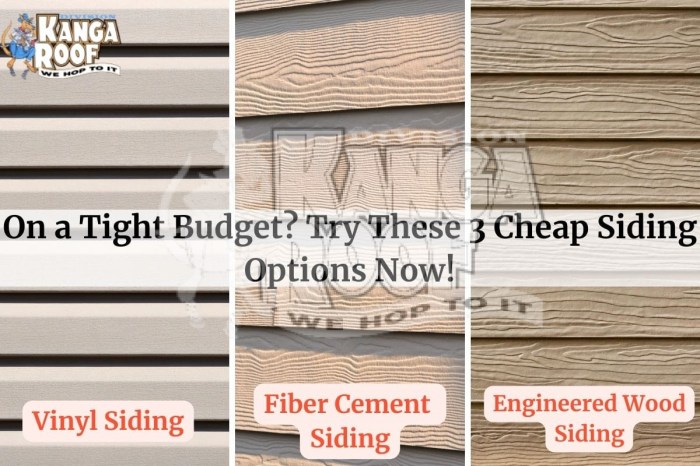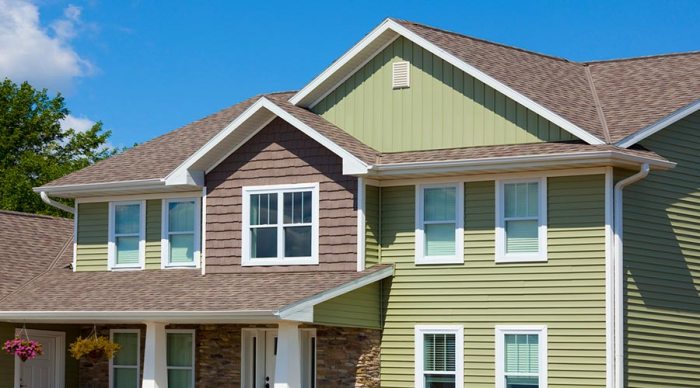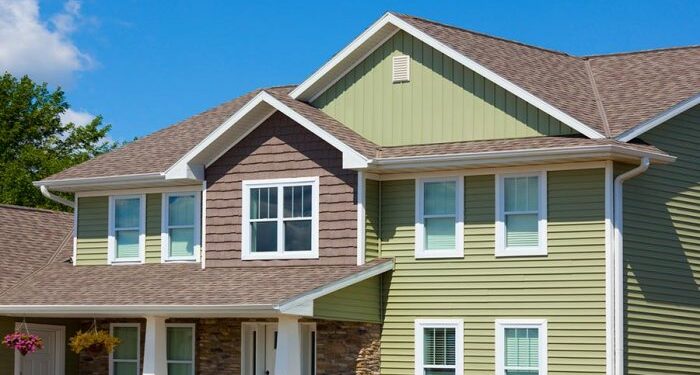Delve into the world of affordable home siding options with this informative guide. From cost-effective materials to energy-efficient choices, this article uncovers everything you need to know to make the best decision for your home.
Discover the different types of siding, compare costs, and learn whether DIY installation or hiring professionals is the way to go. Stay tuned for expert tips and insights that will transform your home's exterior.
Types of Affordable Siding Options
When it comes to choosing affordable siding options for your home, there are several materials to consider. Each type of siding material has its own pros and cons, so it's important to weigh your options carefully before making a decision.
Below, we'll discuss different types of affordable siding materials along with examples of homes showcasing each type of siding.
Vinyl Siding
Vinyl siding is a popular choice for homeowners looking for an affordable and low-maintenance option. It comes in a variety of colors and styles, making it versatile for different home designs. However, vinyl siding may crack or fade over time, and it is not as durable as other materials.
Wood Siding
Wood siding provides a classic and natural look to a home. It can be relatively affordable depending on the type of wood chosen. However, wood siding requires regular maintenance, such as painting or staining, to prevent rot and insect damage.
Fiber Cement Siding
Fiber cement siding is a durable and affordable option that mimics the look of wood or stucco. It is resistant to rot, fire, and insects, making it a low-maintenance choice for homeowners. However, fiber cement siding can be heavy and may require professional installation.
Engineered Wood Siding
Engineered wood siding is a cost-effective alternative to traditional wood siding. It is made from wood fibers and resins, offering the appearance of real wood without the high cost. Engineered wood siding is easy to install and requires minimal upkeep, but it may not have the same longevity as natural wood.
Metal Siding
Metal siding, such as aluminum or steel, is a durable and budget-friendly option for homeowners. It is resistant to fire, rot, and insects, making it a low-maintenance choice. However, metal siding may dent or scratch easily, and it can be prone to rust if not properly maintained.
Cost Comparison of Siding Options
When considering different siding options for your home, cost is a crucial factor to take into account. Here, we will compare the cost of various siding materials per square foot, discuss installation costs, and explore long-term cost considerations such as maintenance and durability.
Siding Material Cost Comparison
| Siding Material | Cost per Square Foot |
|---|---|
| Vinyl | $3
|
| Fiber Cement | $5
|
| Wood | $7
|
| Aluminum | $6
|
Installation Costs Variation
- Vinyl siding typically has lower installation costs due to its lightweight nature and ease of installation.
- Fiber cement siding may have higher installation costs due to its heavier weight and specialized tools required for installation.
- Wood siding can vary in installation costs depending on the type of wood chosen and whether it requires additional treatments.
- Aluminum siding installation costs can be moderate, falling between vinyl and fiber cement options.
Long-Term Cost Considerations
- While vinyl siding may have lower upfront costs, it may require more frequent maintenance and replacement compared to other materials.
- Fiber cement siding is known for its durability and low maintenance requirements, potentially reducing long-term costs.
- Wood siding may require more maintenance over time, such as painting and sealing, which can add to long-term costs.
- Aluminum siding is durable and low maintenance, making it a cost-effective option in the long run.
DIY vs. Professional Installation

When it comes to installing home siding, you have the option to either tackle the project yourself or hire professionals. Each approach has its own costs and benefits, so it's essential to weigh your options carefully before making a decision.
DIY Siding Installation
- Cost Savings: DIY installation can save you money on labor costs, as you won't have to pay for professional services.
- Skill and Experience Required: Installing siding requires a certain level of skill and experience. Make sure you have the necessary tools and knowledge before attempting a DIY installation.
- Time Commitment: DIY siding installation can be time-consuming, especially if you're new to the process. Be prepared to invest a significant amount of time and effort into the project.
Professional Siding Installation
- Expertise: Hiring professionals ensures that the job is done correctly the first time. They have the experience and skills to handle the installation efficiently.
- Time-Saving: Professionals can complete the installation in a fraction of the time it would take for a DIY project, saving you time and hassle.
- Warranty and Guarantee: Many professional contractors offer warranties on their work, providing you with peace of mind in case any issues arise after installation.
Finding Reputable Contractors
- Ask for Recommendations: Seek recommendations from friends, family, or neighbors who have had siding installed recently.
- Check Credentials: Ensure that the contractor is licensed, bonded, and insured to protect yourself and your property.
- Get Multiple Quotes: Obtain quotes from several contractors to compare prices and services before making a decision.
Energy Efficiency of Affordable Siding
When it comes to the energy efficiency of a home, the choice of siding material can play a significant role. Different siding options have varying levels of insulation properties, which can impact the overall energy consumption of a house.
Impact of Siding Materials on Energy Efficiency
Each siding material has its own R-value, which indicates its thermal resistance. The higher the R-value, the better the material is at insulating a home and reducing heat loss or gain.
- Vinyl Siding: Typically has a lower R-value compared to other options, but with proper installation, it can still provide decent insulation.
- Fiber Cement Siding: Offers better insulation properties than vinyl and can help improve energy efficiency.
- Wood Siding: Natural wood siding has good insulation qualities, but it may require more maintenance compared to other materials.
- Aluminum Siding: Generally has a lower R-value and may not be as energy-efficient as other options.
Tips for Improving Energy Efficiency through Siding Choices
Choosing the right siding material and ensuring proper installation can help improve the energy efficiency of your home. Here are some tips:
- Opt for siding with a higher R-value to enhance insulation and reduce energy consumption.
- Consider adding an additional layer of insulation or a vapor barrier underneath the siding for better thermal performance.
- Seal any gaps or cracks in the siding to prevent air leakage, which can lead to energy wastage.
- Regularly maintain and inspect your siding to ensure it remains in good condition and continues to provide adequate insulation.
Conclusion

As we wrap up our exploration of affordable home siding options, remember that with the right choice, your home can not only look great but also save you money in the long run. Make an informed decision and enjoy the benefits of a well-sheathed home.
FAQ Explained
What are some common types of affordable siding materials?
Common types include vinyl, fiber cement, and engineered wood, each with its own set of pros and cons.
How do installation costs vary for different siding materials?
Installation costs can vary based on material complexity and labor requirements, with vinyl often being more affordable to install compared to fiber cement.
Is DIY siding installation a viable option for homeowners?
DIY installation can be a cost-effective choice for those with the right skills, but hiring professionals ensures a faster and potentially more durable outcome.
How do siding materials impact a home's energy efficiency?
Siding materials with higher R-values can improve energy efficiency by providing better insulation, reducing heating and cooling costs in the long term.
What are some tips for finding reputable contractors for siding installation?
Look for contractors with good reviews, proper licensing, and insurance to ensure a smooth and professional siding installation process.














